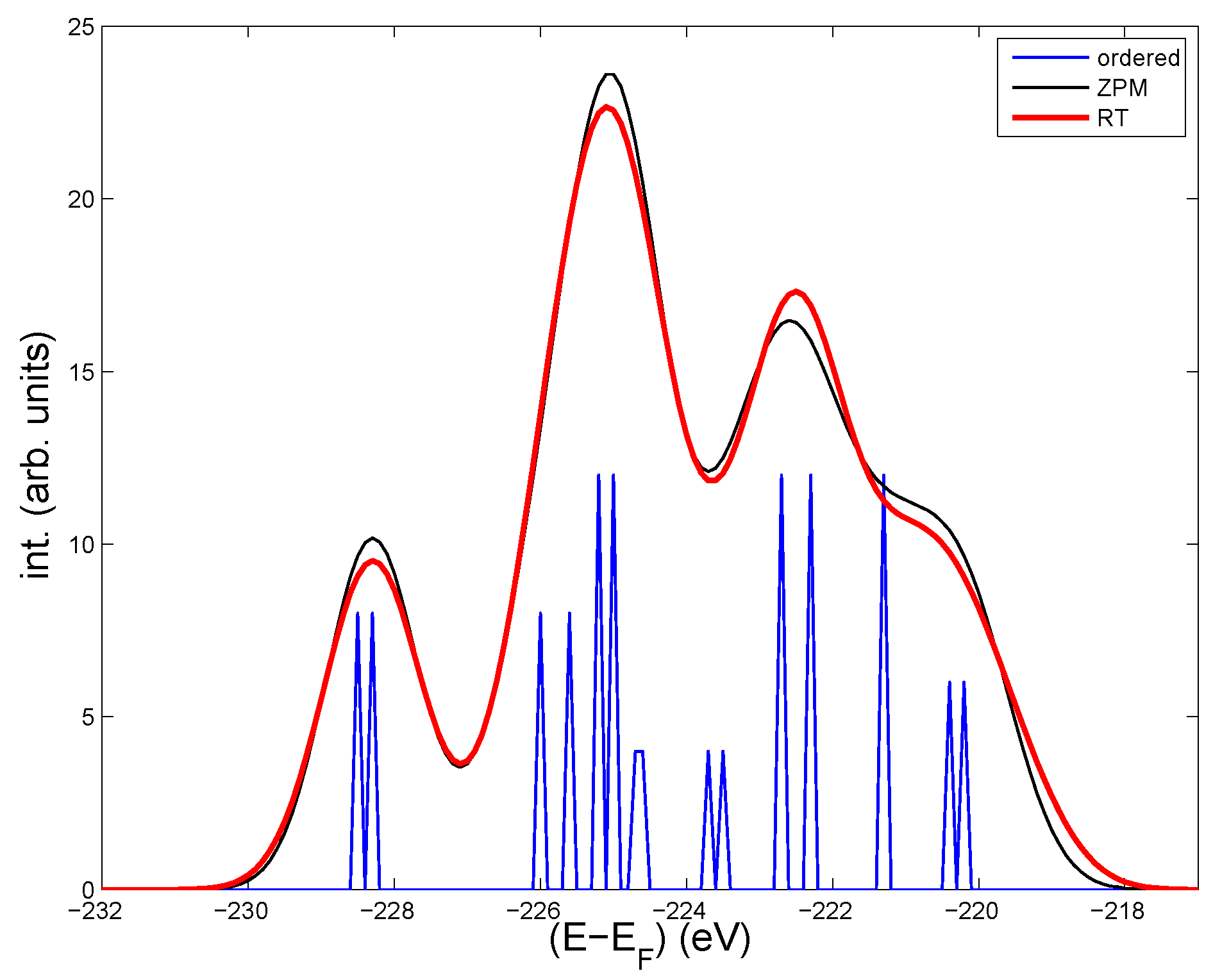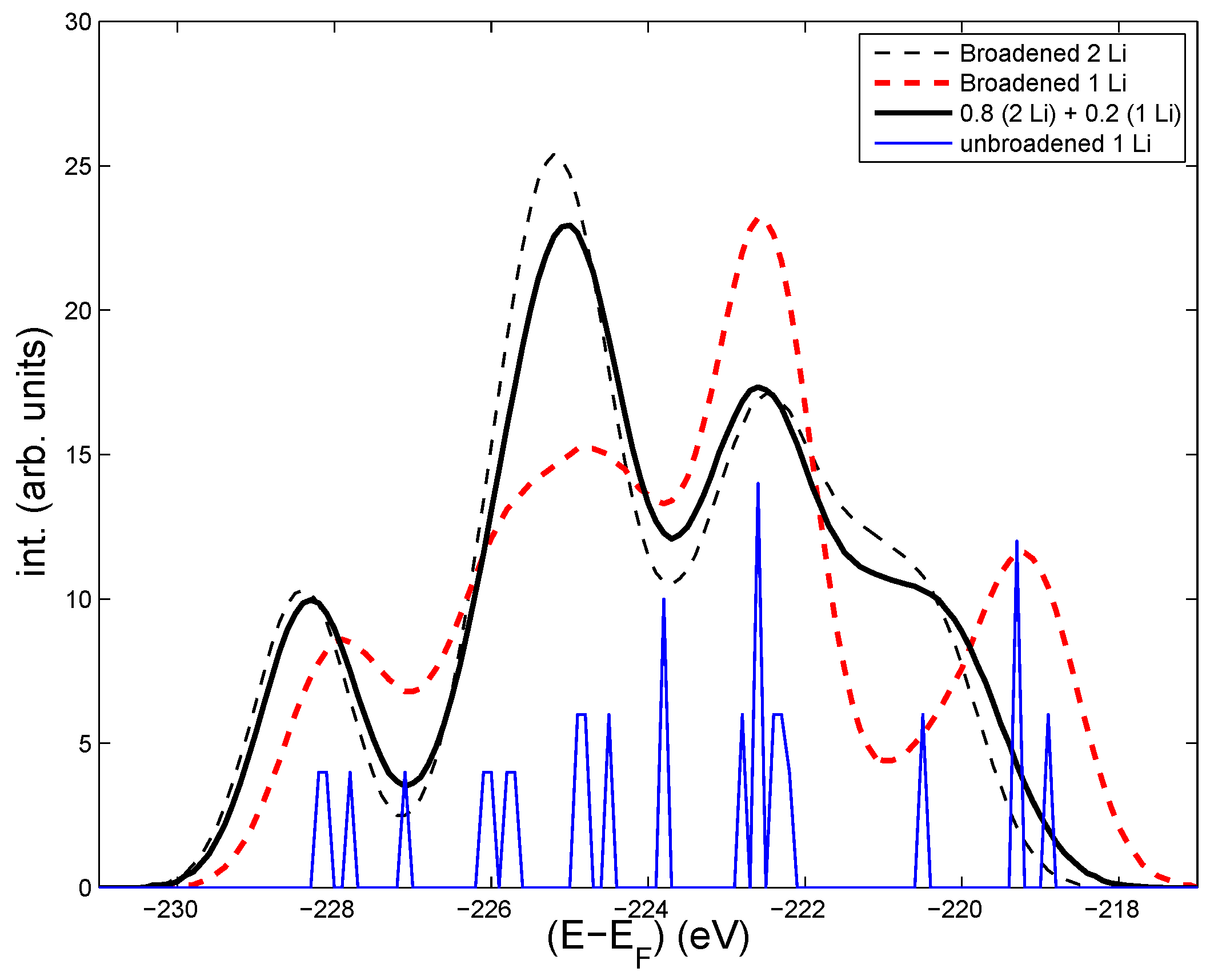Calculated Effects of Disorder on the Mo Core Levels in Purple Bronze Li2Mo12O34 †
Abstract
:1. Introduction
2. Calculations
2.1. Thermal Disorder and Zero-Point Motion
2.2. Static Disorder
2.3. Calculated Results
3. Conclusions
Acknowledgments
Conflicts of Interest
References
- McCarroll, W.H.; Greenblatt, M. Preparation of lithium molybdenum oxide bronzes by a temperature gradient flux growth technique. J. Solid State Chem. 1984, 54, 282. [Google Scholar] [CrossRef]
- Schlenker, C.; Schwenk, H.; Escribe-Filippini, C.; Marcus, J. Superconducting properties of the low dimensional purple bronze Li0.9Mo6O17. Physica B 1985, 135, 511. [Google Scholar] [CrossRef]
- Onoda, M.; Toriumi, K.; Matsuda, Y.; Sato, M. Crystal structure of lithium molybdenum purple bronze Li0.9Mo6O17. J. Solid State Chem. 1987, 66, 163. [Google Scholar] [CrossRef]
- Greenblatt, M.; McCarroll, W.H.; Neifeld, R.; Croft, M.; Waszczak, J.V. Quasi two-dimensional electronic properties of the lithium molybdenum bronze, Li0.9Mo6O17. Solid State Commun. 1984, 51, 671. [Google Scholar] [CrossRef]
- Whangbo, M.-H.; Canadell, E. Band electronic structure of the lithium molybdenum purple bronze Li0.9Mo6O17. J. Am. Chem. Soc. 1988, 110, 358. [Google Scholar] [CrossRef]
- Popović, Z.S.; Satpathy, S. Density-functional study of the Luttinger liquid behavior of the lithium molybdenum purple bronze Li0.9Mo6O17. Phys. Rev. B 2006, 74, 045117. [Google Scholar] [CrossRef]
- Hager, J.; Matzdorf, R.; He, J.; Jin, R.; Mandrus, D.; Cazalilla, M.A.; Plummer, E.W. Non-Fermi-Liquid Behavior in Quasi-One-Dimensional Li0.9Mo6O17. Phys. Rev. Lett. 2005, 95, 186402. [Google Scholar] [CrossRef] [PubMed]
- Xu, X.; Bangura, A.F.; Analytis, J.G.; Fletcher, J.D.; French, M.M.J.; Shannon, N.; He, J.; Zhang, S.; Mandrus, D.; Jin, R.; et al. Directional Field-Induced Metallization of Quasi-One-Dimensional Li0.9Mo6O17. Phys. Rev. Lett. 2009, 102, 206602. [Google Scholar] [CrossRef] [PubMed]
- Podlich, T.; Klinke, M.; Nansseu, B.; Waelsch, M.; Bienert, R.; He, J.; Jin, R.; Mandrus, D.; Matzdorf, R. Luttinger liquid behaviour of Li0.9Mo6O17 studied by scanning tunnelling microscopy. J. Phys. Condens. Matter 2013, 25, 014008. [Google Scholar] [CrossRef] [PubMed]
- Dos Santos, C.A.M.; White, B.D.; Yu, Y.-K.; Neumeier, J.J.; Souza, J.A. Dimensional Crossover in the Purple Bronze Li0.9Mo6O17. Phys. Rev. Lett. 2007, 98, 266405. [Google Scholar] [CrossRef] [PubMed]
- Chakhalian, J.; Salman, Z.; Brewer, J.; Froese, A.; He, J.; Mandrus, D.; Jin, R. Magnetism in purple bronze Li0.9Mo6O17. Physica B 2005, 359–361, 1333. [Google Scholar] [CrossRef]
- Jarlborg, T.; Chudzinski, P.; Giamarchi, T. Effects of thermal and spin fluctuations on the band structure of purple bronze Li2Mo12O34. Phys. Rev. B 2012, 85, 235108. [Google Scholar] [CrossRef]
- Merino, J.; McKenzie, R.H. Effective Hamiltonian for the electronic properties of the quasi-one-dimensional material Li0.9Mo6O17. Phys. Rev. B 2012, 85, 235128. [Google Scholar] [CrossRef]
- Nuss, M.; Aichhorn, M. Effective model for the electronic properties of quasi-one-dimensional purple bronze Li09Mo6O17 based on ab initio calculations. Phys. Rev. B 2014, 89, 045125. [Google Scholar]
- Hedin, L.; Rosengren, A. On temperature broadening in X-ray spectra of metals. J. Phys. F: Metal Phys. 1977, 7, 1339. [Google Scholar] [CrossRef]
- McKenzie, R.H.; Wilkins, J.W. Effect of lattice zero-point motion on electronic properties of the Peierls-Fröhlich state. Phys. Rev. Lett. 1992, 69, 1085. [Google Scholar] [CrossRef] [PubMed]
- Dugdale, S.B.; Jarlborg, T. Thermal disorder versus correlation in Compton profiles from alkali metals. Solid State Commun. 1998, 105, 283. [Google Scholar] [CrossRef]
- Jarlborg, T. Importance of thermal disorder and electronic occupation for temperature dependence of optical conductivity in FeSi and MnSi. Phys. Rev. B 2007, 76, 205105. [Google Scholar] [CrossRef]
- Jarlborg, T. Electronic structure and properties of pure and doped ϵ-FeSi from ab initio local-density theory. Phys. Rev. B 1999, 59, 15002. [Google Scholar] [CrossRef]
- Pedrazzini, P.; Wilhelm, H.; Jaccard, D.; Jarlborg, T.; Schmidt, M.; Helfland, M.; Akselrud, L.; Yuan, H.Q.; Schwarz, U.; Grin, Y.; et al. Metallic State in Cubic FeGe Beyond Its Quantum Phase Transition. Phys. Rev. Lett. 2007, 98, 047204. [Google Scholar] [CrossRef] [PubMed]
- Delaire, O.; Marty, K.; Stone, M.B.; Kent, P.R.C.; Lucas, M.S.; Abernathy, D.L.; Mandrus, D.; Sales, B.C. Phonon softening and metallization of a narrow-gap semiconductor by thermal disorder. Proc. Narl. Acad. Sci. USA 2011, 108, 4725. [Google Scholar] [CrossRef]
- Jarlborg, T. Role of thermal disorder for magnetism and the α-γ transition in cerium: Results from density-functional theory. Phys. Rev. B 2014, 89, 184426. [Google Scholar] [CrossRef]
- Giustino, F.; Louie, S.G.; Cohen, M.L. Electron-Phonon Renormalization of the Direct Band Gap of Diamond. Phys. Rev. Lett. 2010, 105, 265501. [Google Scholar] [CrossRef] [PubMed]
- Jarlborg, T.; Bianconi, A. Breakdown of the Migdal approximation at Lifshitz transitions with giant zero-point motion in the H3S superconductor. Sci. Rep. 2016, 6, 24816. [Google Scholar] [CrossRef] [PubMed]
- Bianconi, A.; Jarlborg, T. Superconductivity above the lowest Earth temperature in pressurized sulfur hydride. Europhys. Lett. 2015, 112, 37001. [Google Scholar] [CrossRef]
- Cannuccia, E.; Marini, A. Effect of the quantum zero-point atomic motion on the optical and electronic properties of diamond and trans-polyacetylene. Phys. Rev. Lett. 2011, 107, 255501. [Google Scholar] [CrossRef] [PubMed]
- Ziman, J.M. Principles of the Theory of Solids; Cambridge University Press: New York, NY, USA, 1971. [Google Scholar]
- Jarlborg, T.; Arbman, G. The electronic structure of some A15 compounds by semiself-consistent band calculations. J. Phys. F: Metal Phys. 1977, 7, 1635. [Google Scholar] [CrossRef]
- Grimvall, G. Thermophysical Properties of Materials; North-Holland: Amsterdam, The Netherlands, 1986. [Google Scholar]
- Requardt, H.; Currat, R.; Monceau, P.; Lorenzo, J.E.; Dianoux, A.J.; Lasjaunias, J.C.; Marcus, J. The phonon density of states and low-temperature specific heat: The blue bronze K0.3MoO3 and the platinum chain compound KCP. J. Phys. Condens. Matter 1997, 9, 8639. [Google Scholar] [CrossRef]
- Andersen, O.K. Linear methods in band theory. Phys. Rev. B 1975, 12, 3060. [Google Scholar] [CrossRef] [Green Version]
- Barbiellini, B.; Dugdale, S.B.; Jarlborg, T. The EPMD-LMTO program for electron–positron momentum density calculations in solids. Comput. Mater. Sci. 2003, 28, 287. [Google Scholar] [CrossRef]
- Kohn, W.; Sham, L.J. Self-consistent equations including exchange and correlation effects. Phys. Rev. 1965, 140, A1133. [Google Scholar] [CrossRef]
- Wang, F.; Alvarez, J.V.; Allen, J.W.; Mo, S.-K.; He, J.; Jin, R.; Mandrus, D.; Höchst, H. Quantum critical scaling in the single-particle spectrum of a novel anisotropic metal. Phys. Rev. Lett. 2009, 103, 136401. [Google Scholar] [CrossRef] [PubMed]
- Wang, F.; Alvarez, J.V.; Mo, S.-K.; Allen, J.W.; Gweon, G.H.; He, J.; Jin, R.; Mandrus, D.; Höchst, H. New Luttinger-Liquid Physics from Photoemission on Li0.9Mo6O17. Phys. Rev. Lett. 2006, 96, 196403. [Google Scholar] [CrossRef] [PubMed]
- Dudy, L.; Denlinger, J.D.; Allen, J.W.; Wang, F.; He, J.; Hitchcock, D.; Sekiyama, A.; Suga, S. Photoemission spectroscopy and the unusually robust one-dimensional physics of lithium purple bronze. J. Phys. Condens. Matter 2013, 25, 014007. [Google Scholar] [CrossRef] [PubMed]
- Gweon, G.H.; Denlinger, J.D.; Allen, J.W.; Olson, C.G.; Hoechst, H.; Marcus, J.; Schlenker, C. Non-Fermi Liquid Angle Resolved Photoemission Line Shapes of Li0.9Mo6O17. Phys. Rev. Lett. 2000, 85, 3985. [Google Scholar] [CrossRef] [PubMed]
- Jarlborg, T.; Moroni, E.G.; Grimvall, G. α-γ transition in Ce from temperature-dependent band-structure calculations Phys. Rev. B 1997, 55, 1288. [Google Scholar] [CrossRef]


| Level | ϵ | ||
|---|---|---|---|
| Mo far from Li (oct. O) | 0.14 | 0.23 | |
| Mo far from Li (oct. O) | 0.10 | 0.12 | |
| Mo intermed. (oct. O) | 0.13 | 0.27 | |
| Mo intermed. (oct. O) | 0.17 | 0.34 | |
| Mo near Li (tet. O) | 0.23 | 0.44 | |
| Mo near Li (tet. O) | 0.25 | 0.66 |
© 2016 by the author; licensee MDPI, Basel, Switzerland. This article is an open access article distributed under the terms and conditions of the Creative Commons Attribution (CC-BY) license ( http://creativecommons.org/licenses/by/4.0/).
Share and Cite
Jarlborg, T. Calculated Effects of Disorder on the Mo Core Levels in Purple Bronze Li2Mo12O34. Condens. Matter 2016, 1, 5. https://doi.org/10.3390/condmat1010005
Jarlborg T. Calculated Effects of Disorder on the Mo Core Levels in Purple Bronze Li2Mo12O34. Condensed Matter. 2016; 1(1):5. https://doi.org/10.3390/condmat1010005
Chicago/Turabian StyleJarlborg, Thomas. 2016. "Calculated Effects of Disorder on the Mo Core Levels in Purple Bronze Li2Mo12O34" Condensed Matter 1, no. 1: 5. https://doi.org/10.3390/condmat1010005






